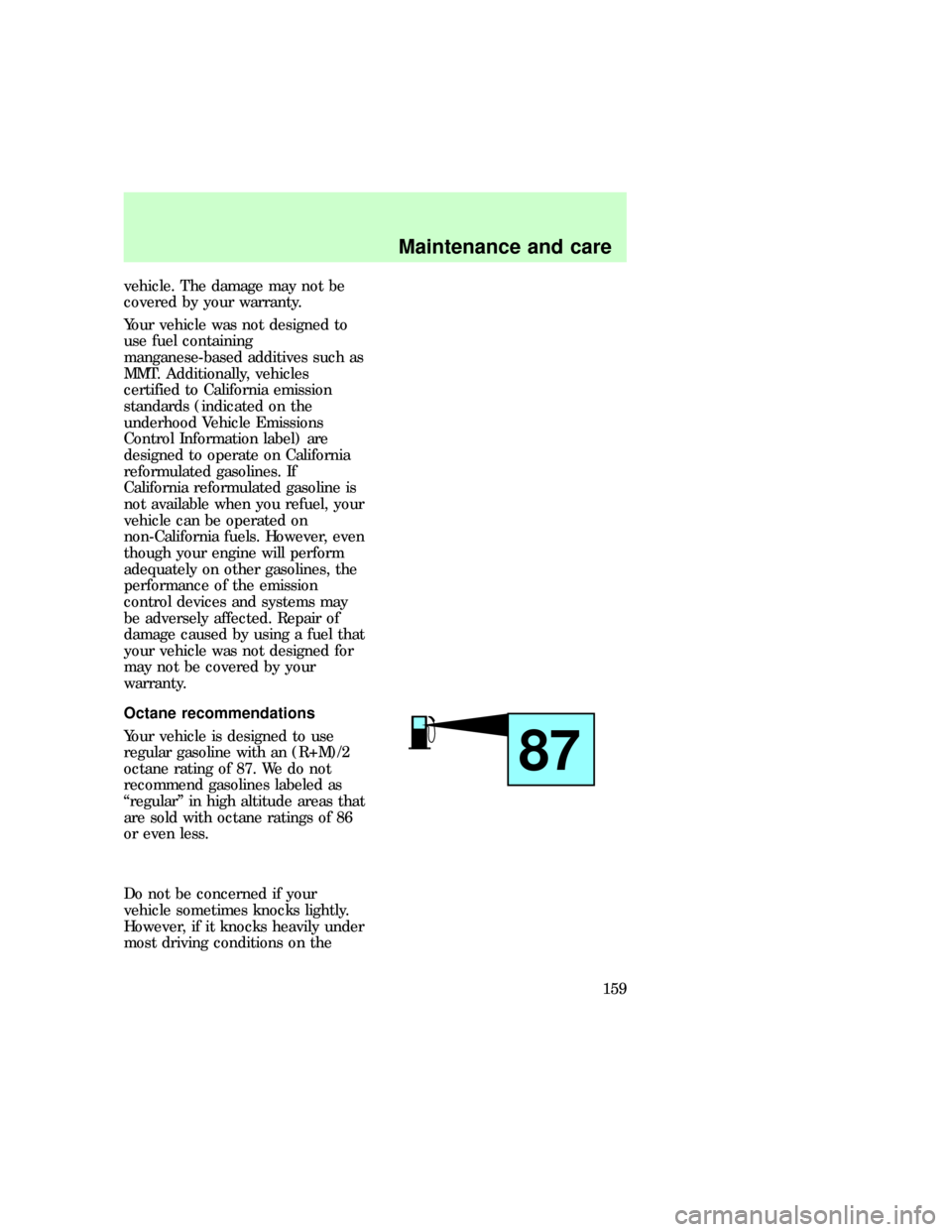Page 125 of 192
The cooling fan is
automatic and may come
on at any time. Always
disconnect the negative terminal
of the battery before working
near the fan.
²If you must work with the
engine running, avoid wearing
loose clothing or jewelry that
could get caught in moving
parts. Take precautions with
long hair.
²Do not work on a vehicle with
the engine running in an
enclosed space, unless you are
sure you have enough
ventilation.
²Keep all lit cigarettes, open
flames and other lit material
away from the battery and all
fuel related parts.
If you disconnect the battery, the
engine must ªrelearnº its idle
conditions before your vehicle will
drive properly, as explained in
Batteryin this chapter.
com_working_off.01
Maintenance and care
125
Page 139 of 192

²loose hose clamps
What you should know about
fail-safe cooling (if equipped)
If the engine coolant supply is
depleted, this feature allows the
vehicle to be driven temporarily
before incremental component
damage is incurred. The ªfail safeº
distance depends on ambient
temperatures, vehicle load and
terrain.
How fail-safe cooling works
If the engine overheats, the engine
will automatically switch from
eight to alternating four cylinder
operation. Each disabled cylinder
acts as an air pump and cools the
engine.
When this occurs, the engine
coolant temperature gauge will
move into the red area and the
light illuminates.
The service engine soon light will
illuminate, indicating that vehicle
service is required.
The vehicle will still operate, but
will have limited engine power and
no air conditioning capability.
Continued operation will increase
engine temperature and cause the
engine to completely shut down.
The vehicle will coast to a stop.
As the engine temperature cools,
the engine may be re-started. Take
your vehicle to a service facility as
soon as possible to minimize
engine damage.
H
C
eco_failsafe_cooling
eco_failsafe_works
eco_failsafe_activated
Maintenance and care
139
Page 159 of 192

vehicle. The damage may not be
covered by your warranty.
Your vehicle was not designed to
use fuel containing
manganese-based additives such as
MMT. Additionally, vehicles
certified to California emission
standards (indicated on the
underhood Vehicle Emissions
Control Information label) are
designed to operate on California
reformulated gasolines. If
California reformulated gasoline is
not available when you refuel, your
vehicle can be operated on
non-California fuels. However, even
though your engine will perform
adequately on other gasolines, the
performance of the emission
control devices and systems may
be adversely affected. Repair of
damage caused by using a fuel that
your vehicle was not designed for
may not be covered by your
warranty.
Octane recommendations
Your vehicle is designed to use
regular gasoline with an (R+M)/2
octane rating of 87. We do not
recommend gasolines labeled as
ªregularº in high altitude areas that
are sold with octane ratings of 86
or even less.
Do not be concerned if your
vehicle sometimes knocks lightly.
However, if it knocks heavily under
most driving conditions on the
87
com_octane_recommendations.01
Maintenance and care
159
Page 160 of 192

recommended octane fuel, see
your dealer or a qualified service
technician to prevent any engine
damage.
Fuel quality
If you are experiencing starting,
rough idle or hesitation problems
try a different brand of fuel. If the
condition persists, see your dealer
or a qualified service technician.
The American Automobile
Manufacturers Association (AAMA)
issued a gasoline specification to
provide information on high quality
fuels that optimize the
performance of your vehicle. We
recommend the use of gasolines
that meet the AAMA specification
if they are available.
It should not be necessary to add
any aftermarket products to your
fuel tank if you continue to use a
high-quality fuel.
Cleaner air
Ford approves the use of gasolines
to improve air quality, including
reformulated gasolines, that
contain oxygenates such as a
maximum of 10% ethanol or 15%
MTBE. There should be no more
than 5% methanol with cosolvents
and additives to protect the fuel
system.
Calculating fuel economy
To accurately calculate your
vehicle's fuel economy:
com_fuel_quality.01
com_cleaner_air.01
com_calculating_economy.01
Maintenance and care
160
Page 183 of 192

Air bag supplemental restraint
system ..........................................52
and child safety seats ..............54
description ................................52
disposal ......................................58
indicator light ...........................57
passenger air bag .....................55
Audio system (see Electronic
sound system) .............................17
Battery .......................................144
servicing ..................................145
Brakes
adjustment ................................80
anti-lock .....................................80
fluid, checking and adding ....134
parking ......................................80
Brake-shift interlock ...................85
Break-in period .............................4
Bulbs, replacing ........................165
headlamps ...............................166
specifications ..........................167
Cleaning your vehicle ...............168
engine compartment ..............170
fabric ........................................172
instrument panel ....................172
plastic parts ............................171
safety belts ..............................172
tail lamps .................................171
washing ....................................168
waxing .....................................169
wheels ......................................170
Climate control system ..............17
Controls
steering column ........................23
Coolant (see Engine coolant)
proper solution .......................137
Driveline universal joint and
slip yoke ....................................144
Driving under special
conditionsheavy load .................................86
Emission control system ..........162
emissions warranty .................163
Engine ........................................178
check engine temperature
warning, message center .......129
Engine block heater ...................77
Engine coolant
checking and adding ..............136
checking hoses .......................138
Engine oil
changing oil and oil filter .......133
specifications ..........................130
Entry system
illumination ...............................36
Exhaust fumes ............................78
Fail safe cooling ........................139
Flashing the lights ......................27
Fuel ............................................157
calculating fuel economy .......161
improving fuel economy ..........99
octane rating ...........................160
quality ......................................160
safety information relating to
automotive fuels .....................157
Fuel pump shut-off switch .......100
Fuse panels
instrument panel ....................104
power distribution box ...........108
Fuses ..........................................102
Gauges, Mechanical ....................11
engine coolant temperature
gauge .........................................12
engine oil pressure gauge ........13
fuel gauge ..................................12
Gearshift ......................................24
Hazard flashers ....................27,100
Headlamps
turning on and off ....................15
Hood ..........................................128
Index
183